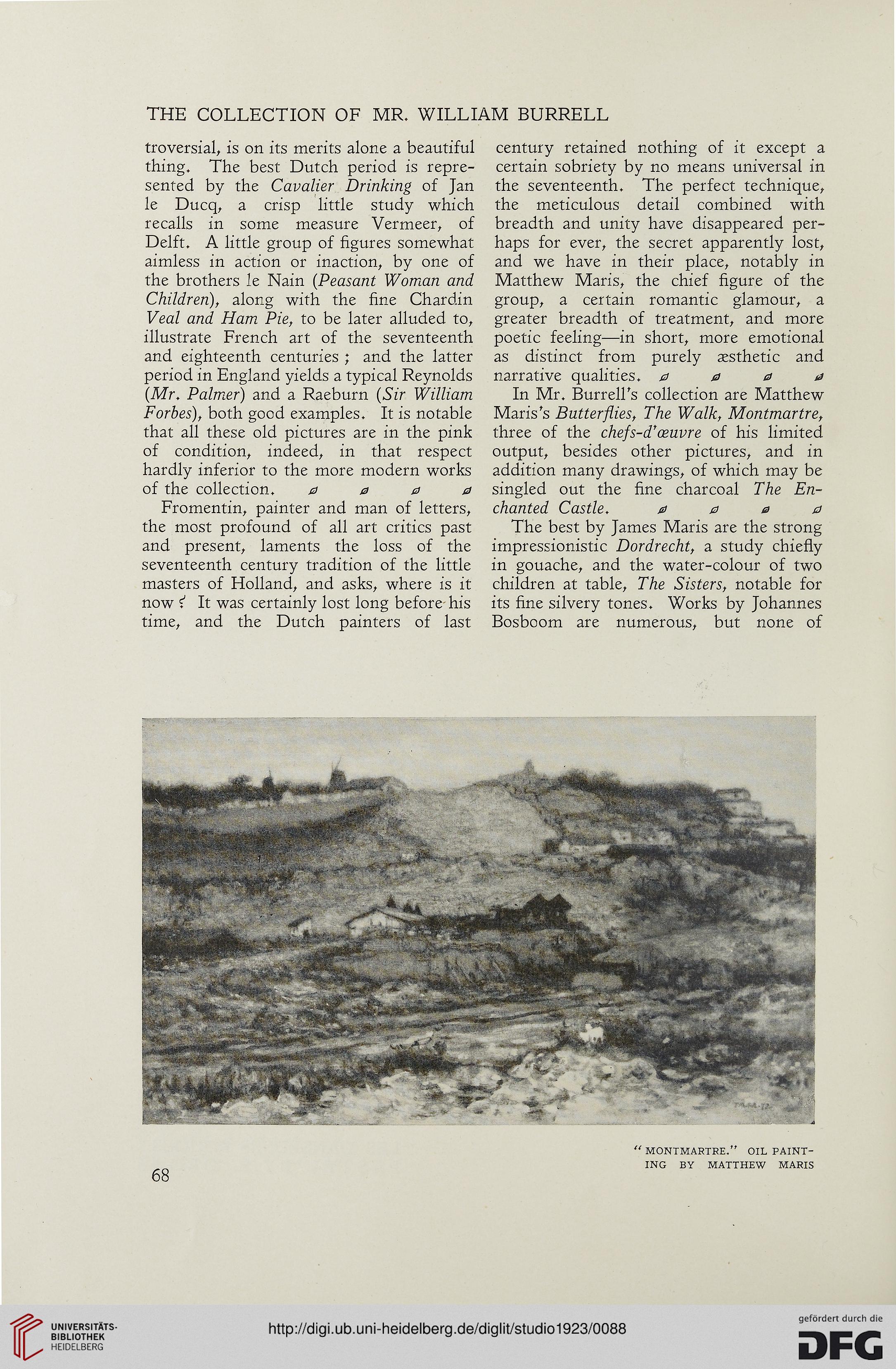THE COLLECTION OF MR. WILLIAM BURRELL
troversial, is on its merits alone a beautiful
thing. The best Dutch period is repre-
sented by the Cavalier Drinking of Jan
le Ducq, a crisp little study which
recalls in some measure Vermeer, of
Delft. A little group of figures somewhat
aimless in action or inaction, by one of
the brothers le Nain (Peasant Woman and
Children), along with the fine Chardin
Veal and Ham Pie, to be later alluded to,
illustrate French art of the seventeenth
and eighteenth centuries ; and the latter
period in England yields a typical Reynolds
(Mr. Palmer) and a Raeburn (Sir William
Forbes), both good examples. It is notable
that all these old pictures are in the pink
of condition, indeed, in that respect
hardly inferior to the more modern works
of the collection. 0000
Fromentin, painter and man of letters,
the most profound of all art critics past
and present, laments the loss of the
seventeenth century tradition of the little
masters of Holland, and asks, where is it
now i It was certainly lost long before his
time, and the Dutch painters of last
century retained nothing of it except a
certain sobriety by no means universal in
the seventeenth. The perfect technique,
the meticulous detail combined with
breadth and unity have disappeared per-
haps for ever, the secret apparently lost,
and we have in their place, notably in
Matthew Maris, the chief figure of the
group, a certain romantic glamour, a
greater breadth of treatment, and more
poetic feeling—in short, more emotional
as distinct from purely aesthetic and
narrative qualities. 0000
In Mr. Burrell's collection are Matthew
Maris's Butterflies, The Walk, Montmartre,
three of the chefs-d'oeuvre of his limited
output, besides other pictures, and in
addition many drawings, of which may be
singled out the fine charcoal The En-
chanted Castle. 0000
The best by James Maris are the strong
impressionistic Dordrecht, a study chiefly
in gouache, and the water-colour of two
children at table. The Sisters, notable for
its fine silvery tones. Works by Johannes
Bosboom are numerous, but none of
68
“ MONTMARTRE.” OIL PAINT-
ING BY MATTHEW MARIS
troversial, is on its merits alone a beautiful
thing. The best Dutch period is repre-
sented by the Cavalier Drinking of Jan
le Ducq, a crisp little study which
recalls in some measure Vermeer, of
Delft. A little group of figures somewhat
aimless in action or inaction, by one of
the brothers le Nain (Peasant Woman and
Children), along with the fine Chardin
Veal and Ham Pie, to be later alluded to,
illustrate French art of the seventeenth
and eighteenth centuries ; and the latter
period in England yields a typical Reynolds
(Mr. Palmer) and a Raeburn (Sir William
Forbes), both good examples. It is notable
that all these old pictures are in the pink
of condition, indeed, in that respect
hardly inferior to the more modern works
of the collection. 0000
Fromentin, painter and man of letters,
the most profound of all art critics past
and present, laments the loss of the
seventeenth century tradition of the little
masters of Holland, and asks, where is it
now i It was certainly lost long before his
time, and the Dutch painters of last
century retained nothing of it except a
certain sobriety by no means universal in
the seventeenth. The perfect technique,
the meticulous detail combined with
breadth and unity have disappeared per-
haps for ever, the secret apparently lost,
and we have in their place, notably in
Matthew Maris, the chief figure of the
group, a certain romantic glamour, a
greater breadth of treatment, and more
poetic feeling—in short, more emotional
as distinct from purely aesthetic and
narrative qualities. 0000
In Mr. Burrell's collection are Matthew
Maris's Butterflies, The Walk, Montmartre,
three of the chefs-d'oeuvre of his limited
output, besides other pictures, and in
addition many drawings, of which may be
singled out the fine charcoal The En-
chanted Castle. 0000
The best by James Maris are the strong
impressionistic Dordrecht, a study chiefly
in gouache, and the water-colour of two
children at table. The Sisters, notable for
its fine silvery tones. Works by Johannes
Bosboom are numerous, but none of
68
“ MONTMARTRE.” OIL PAINT-
ING BY MATTHEW MARIS




